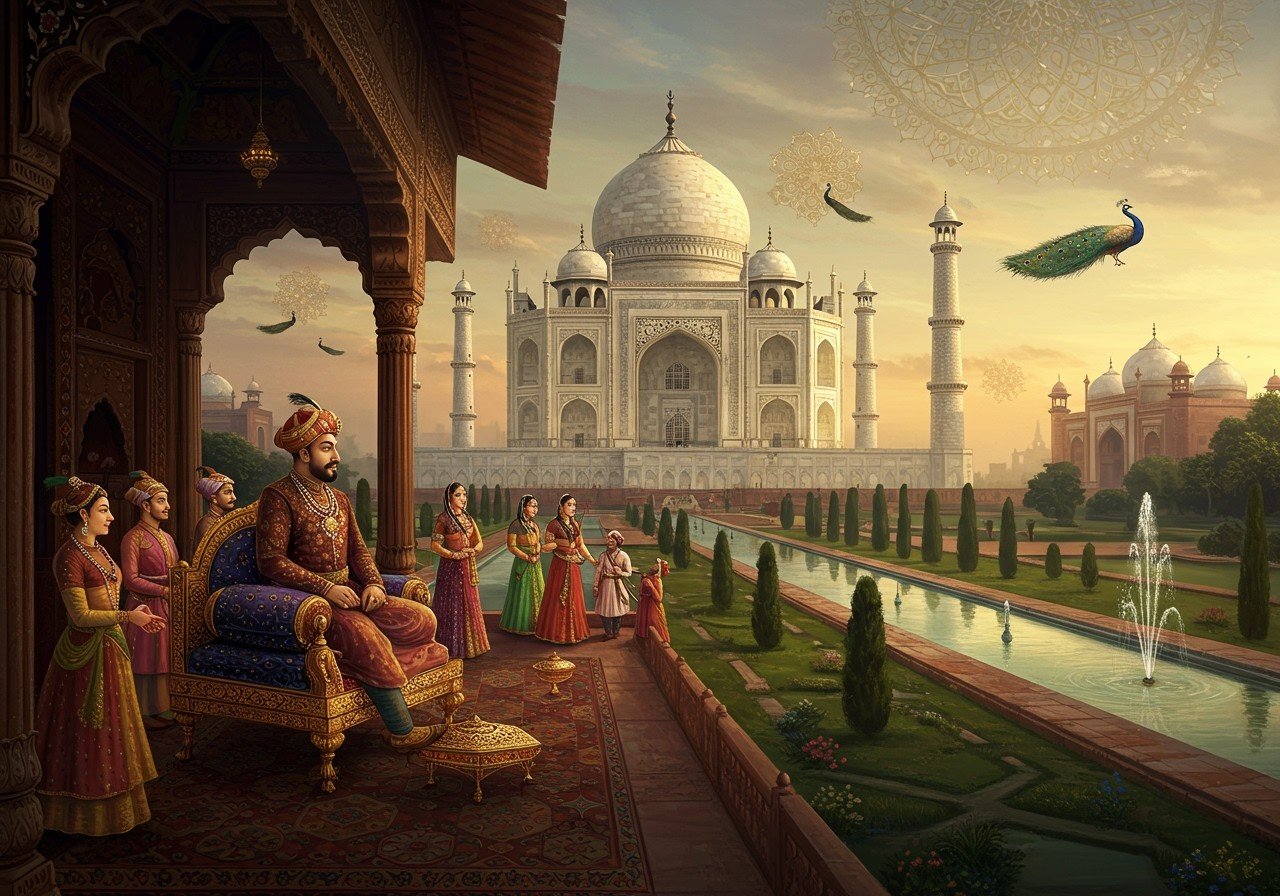
The Mughal Empire stands as a monumental period in India’s history, spanning from 1526 to the mid-19th century. This era witnessed significant cultural, political, and architectural transformations, leaving an enduring legacy on the Indian subcontinent. This article delves into the Mughal Empire’s origins, prominent figures, and lasting impact, offering a glimpse into its profound influence on medieval India. For those seeking a deeper connection with India’s spiritual heritage, Poojn.in offers a wide selection of cultural and religious items.
Origins and Rise of the Mughal Empire
The Mughal Empire’s inception can be traced to Babur’s victory at the Battle of Panipat in 1526. A descendant of Timur and Genghis Khan, Babur’s lineage connected him to powerful conquerors. His strategic use of artillery proved decisive in Indian warfare, giving him a distinct advantage over his adversaries. Initially, Babur encountered resistance from Rajput and Afghan forces. His memoirs, the Baburnama, offer invaluable insights into his conquests and administrative strategies. Following Babur’s death, his son Humayun briefly lost control of the empire but later reclaimed it with the support of the Persian Safavids.
Akbar the Great and the Consolidation of Power (1556-1707)
Akbar’s reign (1556-1605) is renowned for his remarkable administrative and military accomplishments. He championed religious tolerance and integrated Hindus into his administration, appointing Rajput leaders to prominent positions. Akbar established a centralized system through the mansabdari system, organizing the military and bureaucracy based on merit. His expansionist campaigns significantly enlarged the empire’s territory. A patron of the arts, Akbar fostered the development of Mughal painting, architecture, and literature. His capital, Fatehpur Sikri, stands as a testament to Mughal architectural innovation.
Cultural and Scientific Advancements under the Mughals
The Mughal Empire is celebrated for its remarkable cultural and scientific contributions. Iconic structures like the Taj Mahal and Red Fort showcase a unique blend of Persian, Indian, and Islamic architectural styles. Mughal miniature painting flourished under artists like Mir Sayyid Ali. The era also witnessed significant advancements in astronomy, mathematics, and medicine. Literature thrived in Persian, Arabic, and regional languages. The royal court became a vibrant cultural hub, attracting poets, musicians, and scholars. New crops and agricultural techniques were introduced, leading to improved food production. Enhance your understanding of this rich cultural era with authentic puja items and spiritual resources from Poojn.in.
Comparison with the Delhi Sultanate
The Mughal Empire, while succeeding the Delhi Sultanate, exhibited key differences. The Sultanate relied on a decentralized feudal system, while the Mughals implemented a centralized bureaucracy. The Sultanate adhered to stricter Islamic rule, whereas the Mughals, particularly under Akbar, promoted religious tolerance. Architectural legacies like the Qutb Minar from the Sultanate period influenced Mughal constructions.
Legacy and Impact of the Mughal Empire
The Mughal Empire’s legacy continues to shape India’s cultural and historical landscape. From architectural marvels like the Taj Mahal to Akbar’s administrative reforms, the Mughals made significant contributions to India’s development. Their promotion of arts, sciences, and religious tolerance laid the foundation for a rich and diverse heritage. The Mughal influence is evident in the fusion of traditions and modernity in India today. Reflecting on this era allows us to appreciate the power of unity, integration, and progress, honoring the enduring impact of the Mughal dynasty on the vibrant tapestry of Indian history.
FAQs: Understanding the Mughal Era
What defined the Mughal Empire? The Mughal Empire, a dominant force in medieval India, was established in 1526 by Babur and lasted until the mid-19th century. At its zenith, the empire encompassed nearly the entire Indian subcontinent, integrating diverse cultures under its rule.
Who were the key Mughal rulers? Key figures include Babur, Humayun, Akbar, Jahangir, Shah Jahan, and Aurangzeb. Each emperor played a crucial role in shaping the empire’s trajectory, from military expansion to cultural patronage.
How did the Mughal Empire influence Indian culture? The Mughals significantly influenced Indian culture through the introduction of Persian art, architecture, and language. The Taj Mahal stands as an iconic symbol of this cultural fusion.
What characterized Mughal administration? Mughal administration was centralized, emphasizing law and order. The mansabdari system structured governance, while a sophisticated revenue collection system supported the empire’s finances. Connect with this rich history through traditional puja items available at Poojn.in.
What factors contributed to the Mughal decline? The decline stemmed from internal conflicts, weakened leadership after Aurangzeb, and the rise of regional powers like the Marathas. These factors gradually eroded the empire’s authority and paved the way for British colonization.
How did the Mughal Empire differ from the Delhi Sultanate? The Mughal Empire succeeded the Delhi Sultanate, but differed in its centralized administration and greater cultural impact. The Mughals fostered a more sophisticated system of governance and left a more enduring legacy.
Where were the Mughal centers of power? The primary centers of power were Delhi, Agra, and Lahore, serving as political and cultural hubs of the empire. These cities showcased the grandeur and administrative prowess of the Mughals.
Why is the Mughal period considered pivotal in medieval India? The Mughal era is considered a defining period due to its contributions to art, architecture, and administration, shaping India’s cultural and political landscape for centuries. Discover artifacts and spiritual resources related to this era at Poojn.in.


